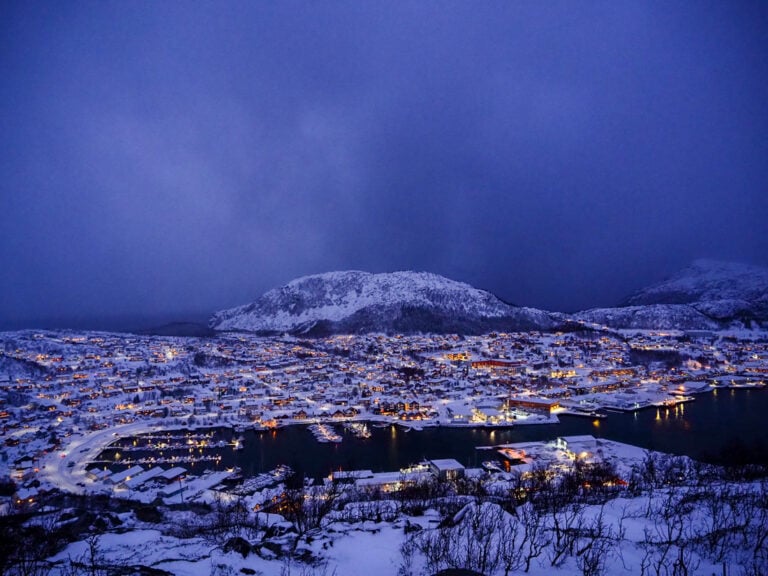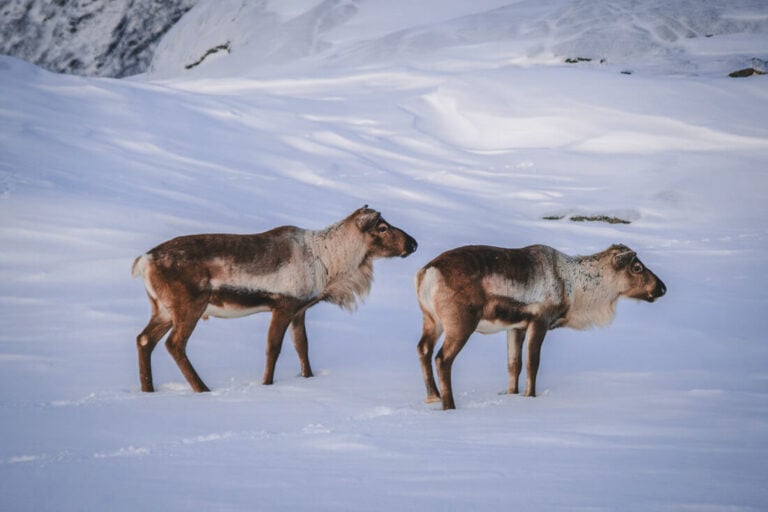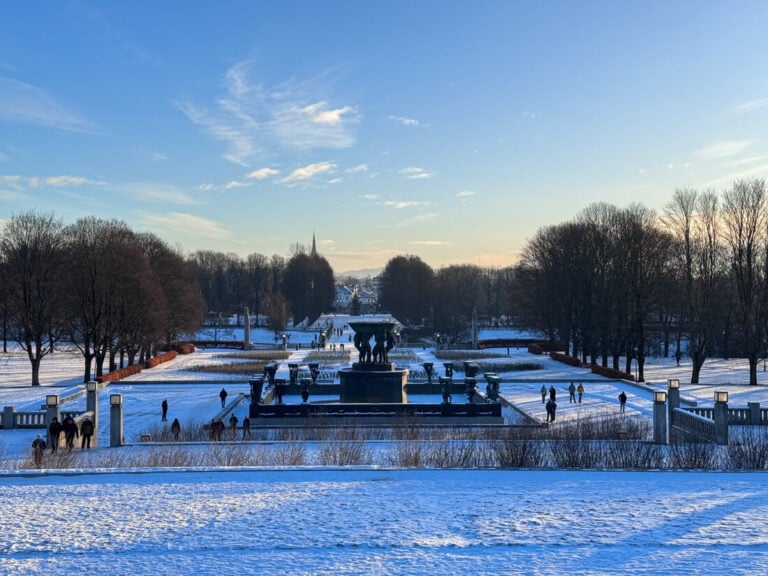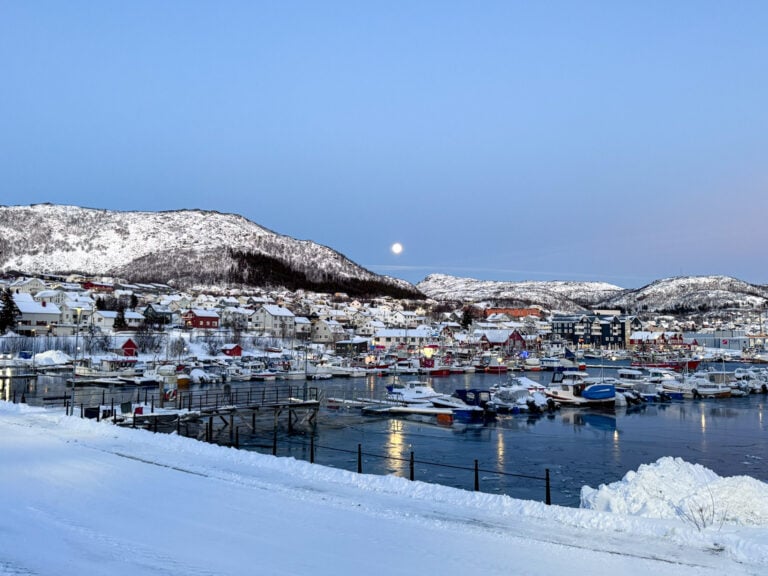A Guide to Whale Watching in Tromso (+ Best Tours in 2025)

Are you looking to go whale watching in Norway? If so, Tromsø is the perfect destination.
During the winter months, Northern Norway is one of the best places in Europe for whale sightings.
I’ve been lucky enough to go whale watching in various places around the world—including Iceland, New Zealand, Canada, and even Antarctica. But nothing compares to my experience in Norway. We encountered hundreds of orcas and humpback whales displaying fascinating behaviours. It was truly unlike anything I’ve seen before.

Whales hold a special place in my heart, and while I’m passionate about these magnificent creatures and want to see them as much as I can, I’m also mindful of some ethical concerns surrounding whale watching.
With this in mind, I decided to join a specialist expedition run by a whale expert, and we spent a whole week searching for whales and observing their behaviour.
In this guide, I’ve shared everything I know about whale watching in Tromso. This includes the best tours, the best time of year, and how to ensure your experience is ethical. I’ve also included a brief guide on swimming with whales in Norway.
My personal Tromso whale watching experience
Storytime! I have a genuine love and passion for whales and dolphins. So much so that I’m considering a career in protecting them.
One of my dreams has been to see orcas (killer whales) in the wild. There is something so unique and wonderful about these creatures. I could talk about them all day (don’t worry, I won’t).
I’ve travelled the world to see orcas, literally! I’ve tried in SO many places where you are basically guaranteed to see them. It actually became a joke amongst my friends. I tried West Iceland, the Galapagos, Vancouver, New Zealand, and Antarctica… but no luck!
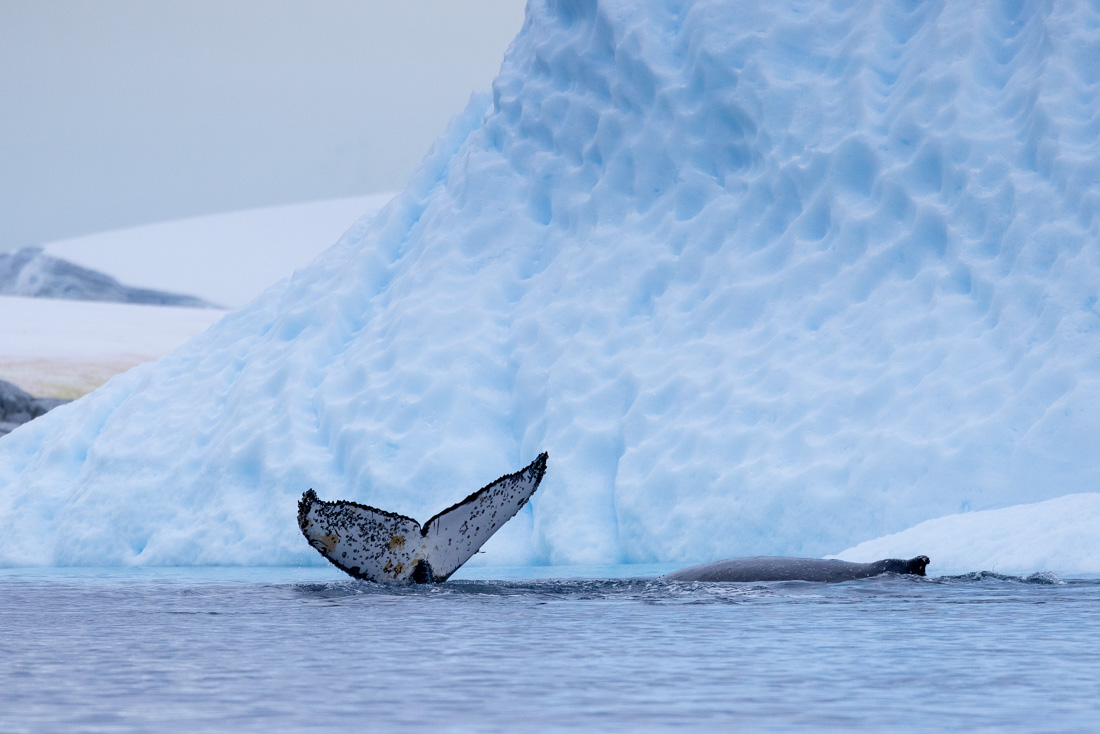
I always knew visiting Norway during the winter would give me the best chance at seeing orcas. However, Norway is SO expensive, plus I’d heard about ethical concerns around some whale watching there (see more on that below).
One day, I saw a cetacean (whale and dolphin) expert was planning a seven-day expedition in Norway. Knowing that the tour would be as ethical as possible, I jumped at the chance.
Despite being delayed by a bad storm, we spent five days on the water. Each day was unique, and we saw so many different marine mammals.
And… I FINALLY got to see orcas. Not just a few, HUNDREDS of them. Every day. We also saw groups of 30+ humpback whales all swimming together (this is incredibly rare) and orcas feeding.

There aren’t many places in the world where you can see whales on this scale. It’s also very rare to see humpbacks and orcas together like this.
About Tromso whale watching
Tromso whale watching season
The best time of year to see whales from Tromso is between mid-November and mid-January, during Norway’s winter.
During this period, Atlantic herring fill the fjords of Northern Norway, creating gigantic feeding grounds for marine life. This also coincides with the best time to see the Northern Lights.
Due to climate change and changing weather, the time of year the whales arrive and leave can vary slightly. For the best chance of seeing them, I suggest a late November or December trip. The whales tend to have departed by the end of January.
As the whales are above the Arctic Circle, you’ll also experience the polar night. This is when the sun doesn’t rise above the horizon.
This might make you wonder if doing the tour is worth it, but I promise it is! Despite the sun not rising, there is still some twilight for a few hours each day. On days without clouds, the lighting can be magnificent with pinks and purples.

Where to see whales in Tromso
I keep referring to the whale watching being in Tromso, but that’s incorrect. While many tours begin in Tromso, you must travel north to reach the whales.
The whales used to be in the Tromso region, but they have decided to stay further north in recent years. Currently, the best place to see the whales is the Skjervøy area.
If you’re joining a tour from Tromso, the boats must travel north for two hours to reach the primary feeding grounds (something many tours fail to tell you!). Alternatively, some tours have a coach transfer included to Skjervoy.

Personally, I think the best option is to either have a coach transfer to Skjervoy or travel there independently. The boats from Tromso don’t always have the time to explore the feeding ground areas as much.
We were based in Skjervoy for the week, and our driver took us to some smaller fjords with so much action (think giant feedings with hundreds of whales). Most tours from Tromso don’t have the time to explore this much.
There are several companies which operate from Skjervoy, which I’ve spoken more about below.
Alta is another whale hot spot in Northern Norway, although this is a little trickier to reach.

What whales might you see?
Northern Norway is a haven for whales during winter, and there’s a chance to see several species.
For the most part, it’s humpback whales and orcas (killer whales) which are sighted on the tours. These also tend to be the most active whales, and it’s not uncommon to see breaches, spy hops and tail-slapping.
We saw groups of 30+ humpbacks swimming past us. I’ve honestly never seen whales on this scale before (even in Antarctica).
It’s also possible to see Fin whales (the second largest whale on the planet). They don’t tend to show much surface activity, but they’re still incredible.
In recent years, there have also been sightings of sperm whales. And if you’re really lucky, you may get to see minke whales or even a blue whale (although this is very rare).
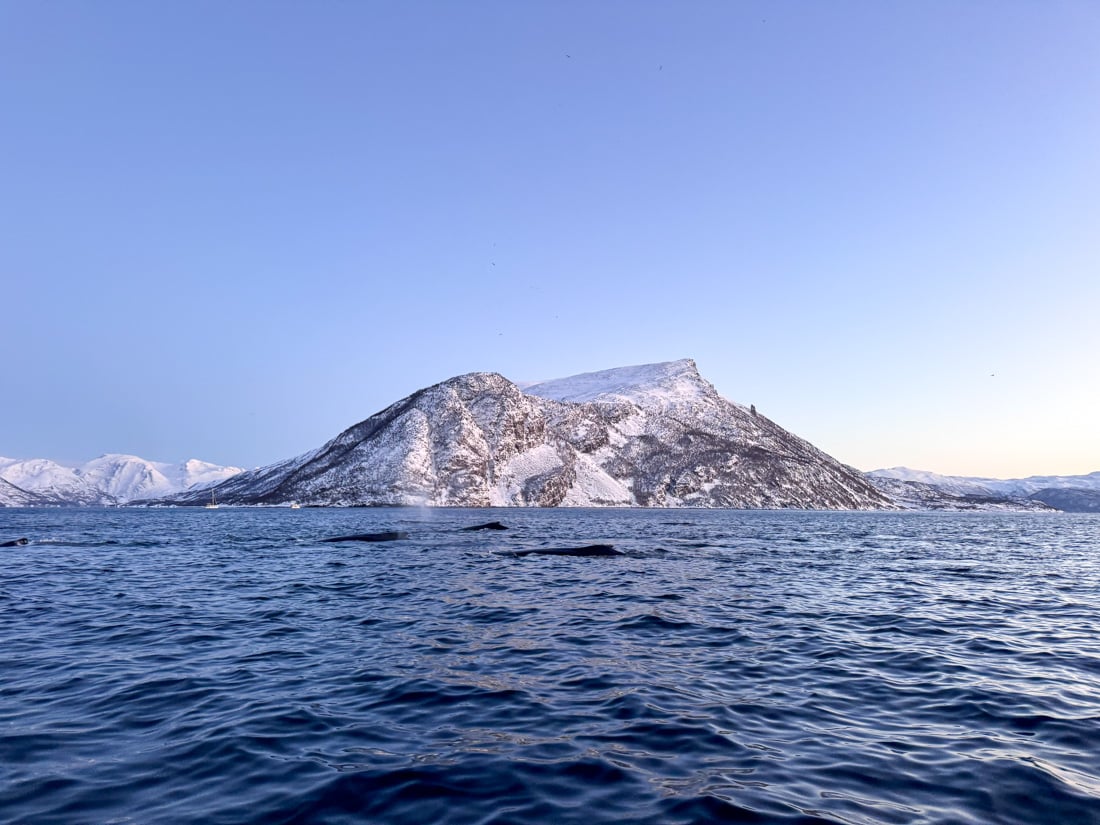
Are you guaranteed to see whales?
When it comes to wildlife, nothing is ever guaranteed. The whales of Norway are entirely wild, and they can leave the area whenever they like.
However, the chances of encountering whales in the Skjervoy area are pretty much as good as they get (at least from mid-November until mid-January).
I went out five times and saw countless whales every single day. It’s very rare not to see them on a tour, but it can happen.
Check with your tour operator to see their policy for if you don’t see any whales.
Ethical and responsible whale watching in Norway
Let’s discuss the elephant in the room – is whale watching ethical? Personally, I think it can be, but the boats need to follow some strict rules.
Responsible travel is something I am learning more and more about every day, and it’s becoming very important to me, especially regarding wildlife.
I could write an entire essay on responsible whale watching, but no one wants to read that. However, I do think it’s important to touch upon some of the ethics around whale watching in Tromso.
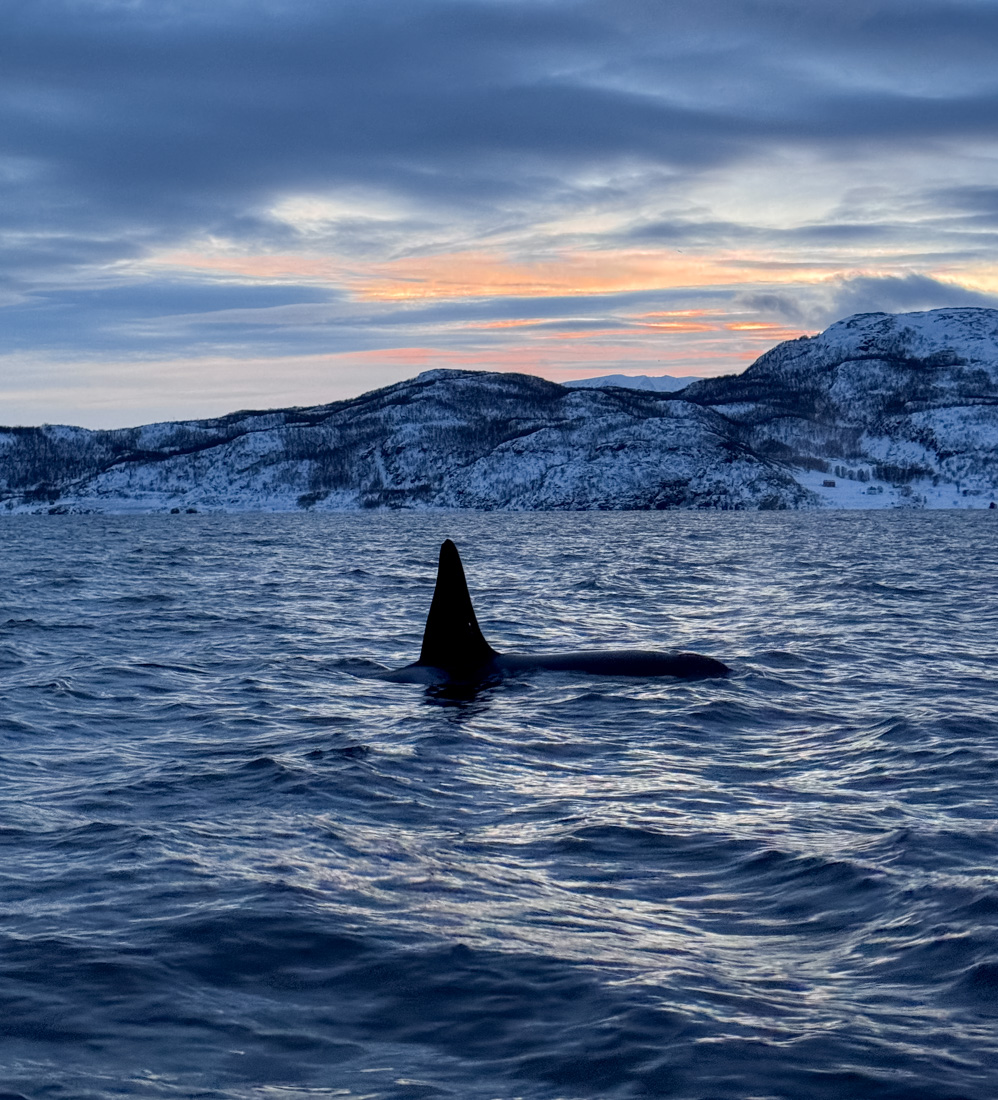
One thing to point out is that the whales of Norway are very used to boats. Thanks to the fishing industry, the whales don’t panic when they see a ship, unlike some whales in other parts of the world. This is great news as a whale watching boat is much less likely to affect a whale.
However, unlike some other countries, Norway doesn’t have strict regulations for whale watching boats. While there are some guidelines, there’s nothing stopping boats from chasing the whales or getting too close (something I witnessed on several occasions).
Another issue is the amount of boats around the whales. One day, we saw a humpback whale constantly breaching out of the water. It was incredible, but about seven boats started to chase the whale and get close to it.
This was so uncomfortable to watch. Thankfully, our driver noticed this and we went off to find whales elsewhere.
Ultimately, the tour companies want to give you the best experience possible. They know this is a bucket list activity for many, and they’re only doing what they think is right for their customers.
However, it’s important to respect that this is the whale’s home, and we are just visiting. When I went whale watching in Husavik (Iceland), there were strict rules about how close you can get to the whales and how long you can stay with them.

As I said before, it’s slightly different in Norway as the whales are very familiar with boats, but that doesn’t mean we should affect their behaviour.
I can’t say a bad word about my whale-watching experience in Skjervoy, and I saw many other boats respecting the whales and not getting too close (unless the whales chose to get close to them, which happens a lot). But I also witnessed some boats chasing the whales and disrupting their behaviour.
It’s often hard to know how a tour operates before doing the tour, but you can do the following to try and get an idea:
- Read reviews online to see if anyone has mentioned any poor behaviour
- Check the website for any responsible tourism pledges
- Email a company before booking and ask what their policies are
I also want to mention that Norway is still a whaling country. Each year, hundreds of whales are killed for food. Tourism is a great way to help protect the whales. It shows the government and locals that these fantastic creatures are worth protecting, and we want to see them alive (not in a burger).
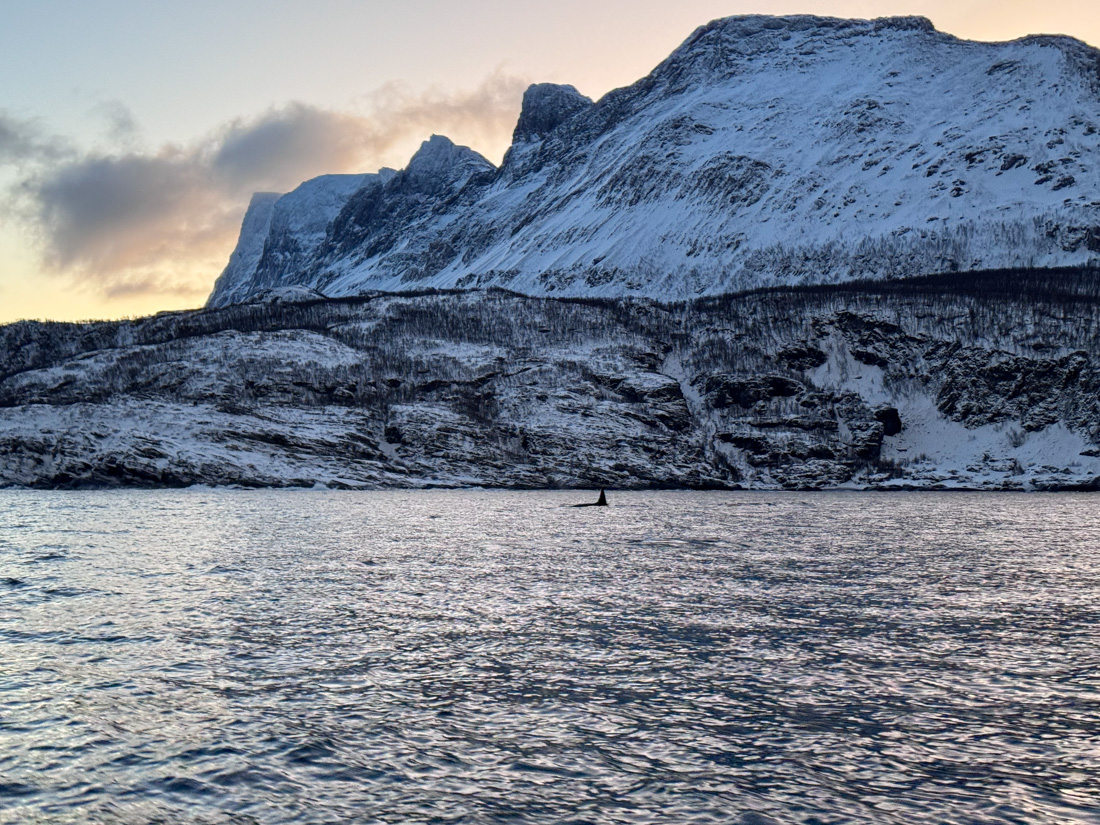
The best whale watching tours in Tromso
Choosing the right tour for you
Whale watching is one of the best things to do in Tromso, and there’s no shortage of tour operators.
Firstly, let’s talk about the different types of tours.
RIB boat tour
A RIB tour is one of the most popular options. These small inflatable boats can move faster, get you closer to the whales, and seat only a few people. They can also navigate rough seas a little easier.
The only downside is it can be FREEZING and very bumpy. However, most tour operators will give you thermal suits to stay warm.
If you want to do a RIB boat tour, you’ll need to head to Skjervoy first.
Small or large boat
If you don’t fancy a RIB tour, the next best option is a small boat tour. The smaller boats only hold around 12 people so it’s still an intimate experience, but they tend to be a bit less bumpy than the RIBs.
They can also quickly get you to the location of the whales.
If you want to take the boat from Tromso, you’ll be looking at a large boat or catamaran. These are an excellent choice for those who want an indoor area to stay warm, toilets and other facilities.
However, they carry a lot of passengers, and it can feel a little touristy. The larger boats from Tromso also have further to travel, so they don’t tend to always get to the main activity.
Most of the small and large boats include hot drinks, but you can check this at the time of booking.
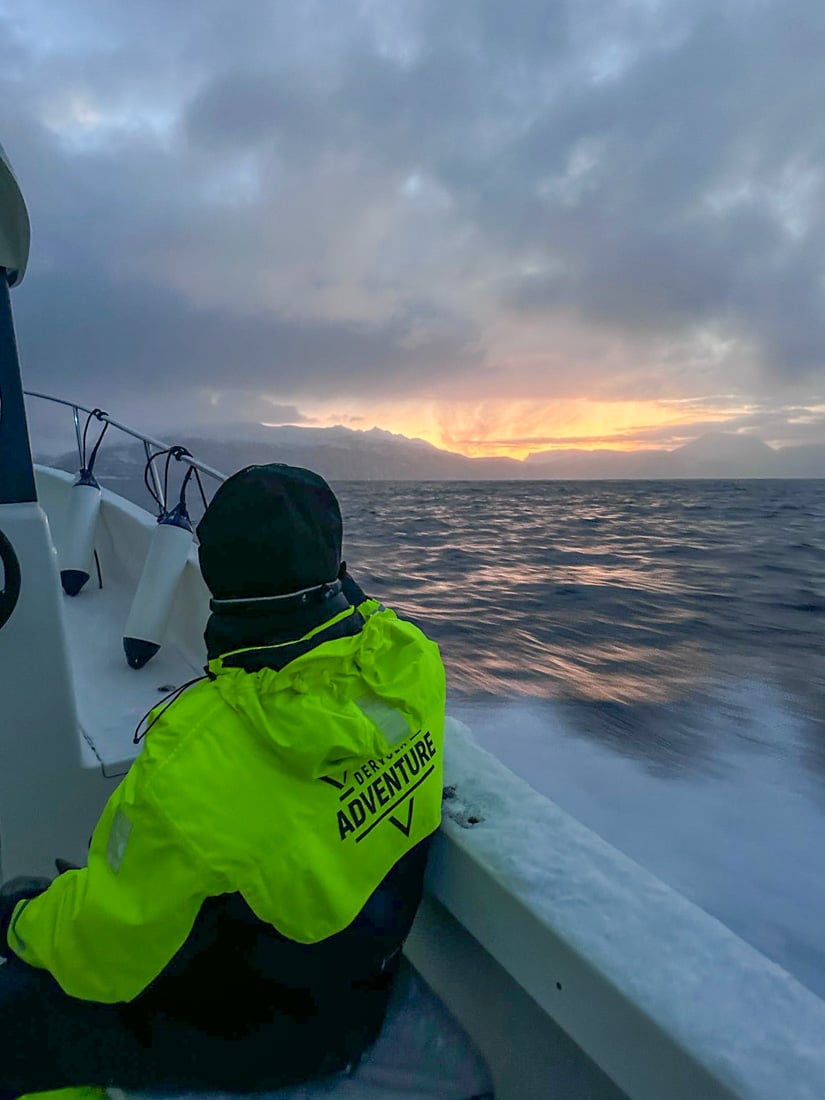
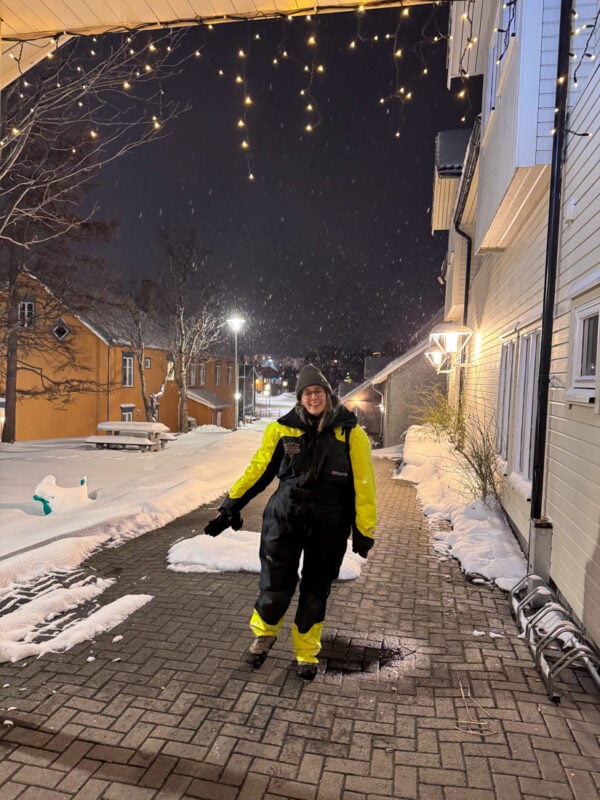
Which is best?
Personally, the smaller the better. I normally love RIB boats but it can get VERY cold in Norway, which is why I was happy to be on a small boat with a small indoor area (although it was still freezing).
If you’re up for an Arctic adventure, consider a RIB boat or small boat. If you prefer comfort and don’t mind travelling from Tromso, go for a bigger boat.
Best whale tours from Tromso
Here are a few of my favourite whale tours in Norway departing from both Tromso and Skjervoy. This is by no means a list of every tour, but they’re ones I’ve had personal experience with or have knowledge of their practices.
My favourite whale watching company is Dervola – this is who I spent the week with. I honestly can’t recommend them enough. They have knowledgeable guides, operate with small groups, genuinely care about the whales and know all the best spots.
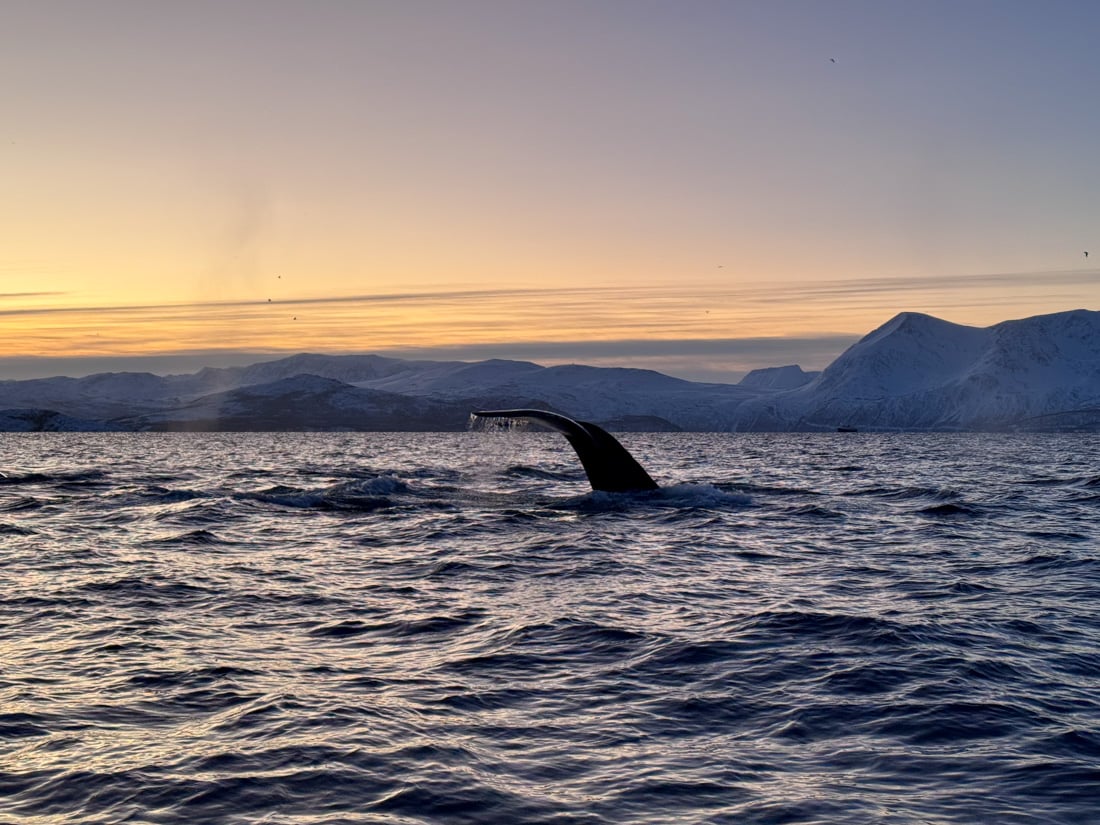
Some of the other best whale watching tours in Tromso include:
From Tromso
- Fancy a silent whale watching tour? This catamaran tour with Brim Explorer has a silent electric engine, meaning less disturbance to the whales.
- For a RIB boat tour from Tromso, this tour includes your transport to Skjervoy.
From Skjervoy
- If you’re looking for a RIB tour in Skjervoy, look no further than this whale safari.
- Dervola uses small boats for their tours, and it’s a great in-between with a warm inside area but still a small group. I can’t recommend them enough.
I would dedicate the whole day to your tour, especially if you travel from Tromso and back. For the most part, the tours return in time for Northern Lights tours (but check this when you book).
How much is whale watching in Tromso?
The price of whale watching varies depending on the tour you choose and if you travel from Tromso or Skjervoy.
Typically speaking, the cheapest tours are the larger boats which start at around $150 per person. The RIB boats are more expensive at around $260. However, you’ll cover more ground and get closer to the whales on a RIB or small boat.
It’s a sensible idea to book as far in advance as possible. Whale watching is one of the most popular activities in Tromso, and you don’t want to miss out.
Note: Poor weather conditions can cause tours to be cancelled. If whale watching is high on your list, I suggest giving yourself some buffer days for bad weather. While the arctic wildlife isn’t affected by rough seas, it might be dangerous on the boats.


What to wear and take on your tour
Put simply: dress as warmly as you possibly can and wear more layers than you think you’ll need.
I don’t think I have ever been as cold in my life as when I was out on that boat. The water was freezing as soon as it hit the boat. It was SO cold. Not only are you dealing with below-freezing temperatures, but there’s also often a cold arctic wind.
If you choose a bigger boat, you’ll likely have a warm indoor area where you can warm up. However, I still think it’s worth dressing warmly. You don’t want to be stuck inside looking out of a window.
The small boats and RIB boats provide thermal suits. However, they’re not as warm as they look. To stay warm, I wore:
- A thermal long-sleeved top
- Another thermal top
- A thermal fleece
- A regular fleece
- Another fleece
- A down coat
- Thermal leggings
- Regular leggings
- A thermal suit
- Buff
- Hat
- 2 pairs of gloves
Honestly, it’s freezing out there.
In terms of what to pack, I recommend taking an extra layer or two just in case you get cold. Other ideas include:
- A spare pair of gloves (your gloves can get wet as you walk around the boat)
- A spare pair of socks (my feet got a bit wet out on the boat)
- Waterproof jacket for an extra layer of wind and water protection
- Hand warmers to warm up your hands
- Camera equipment
- A portable battery charger
- Snacks
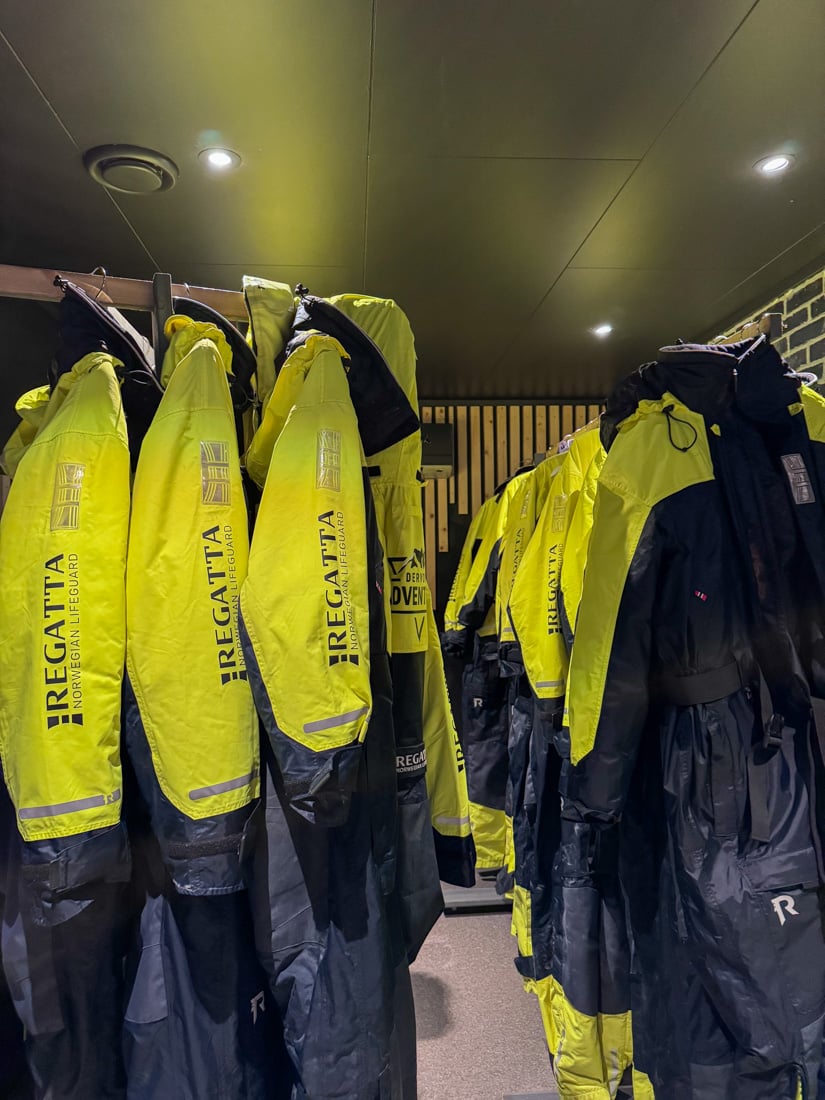
Swimming with whales in Norway
Snorkelling with whales is becoming a popular activity in Northern Norway. Swimming alongside orcas and humpbacks in the Arctic waters is definitely a bucket list experience, but is it ethical?
Swimming with orcas has long been at the top of my bucket list. However, I’ve been hesitant. There’s a long list of ethical concerns around the activity, and sadly, I saw some poor behaviour from some operators while in Skjervoy. I had planned to do a day swim but cancelled my booking due to what I had witnessed.
The main issue is the tour guides want to do everything they can to get you in the water, especially on the day tours. This means throwing in-experienced swimmers into the path of large whales. And sometimes in poor weather with a rough swell and low visibility.
The whales themselves are unlikely to hurt you, but it would be easy to panic in the water (especially in a dry suit) or get hit by a boat. I also saw people being told to jump in when it wasn’t the right time for the orcas. This completely disrupts their behaviour and is, quite frankly, very unfair.
These are wild animals and it’s essential that we respect them, their space and their behaviours.
I spoke to a cetacean expert about the issue. She’s not against swimming with the whales, but you need to choose an operator who understands whale behaviour and has their welfare as the priority.

If you want to swim with orcas in Tromso, I highly recommend booking a multi-day tour. While more expensive, they don’t have as much pressure to quickly get you into the water and tend to have better practices than day tours. They can also travel further from the Skjervoy area to avoid other boats.
One excellent option is Reel Lofoten / Trio II. You’ll sleep on a boat in the Skjervoy harbour and travel each day to the whales. I met several people who were on an expedition with them and they only had good things to say. Waterproof Expeditions are another great option, and they tend to avoid the busier areas.
If you can, try to avoid the day tours.
Swimming with orcas is definitely something I want to do in the future, but I want to make sure it’s done in the most ethical and natural way possible.
Summary: Is whale watching in Tromso worth it?
The whale watching I did in Northern Norway is some of the best I’ve EVER done (and I’ve done a lot). It’s one of the best things to do in Norway during the winter, and for very good reason.
There is something so magical about cruising through the Norwegian Fjords during the polar night, surrounded by incredible wildlife on a scale like nowhere else on the planet.
While it’s a fantastic activity, I do encourage you to research your chosen operator to ensure they operate as ethically as possible.
I absolutely loved my time whale watching in Norway; it’s one of my top travel experiences. I learned so much about whales, how to be ethical around them, and why it’s more important than ever to protect them.
Continue planning your trip to Norway with my guides:

